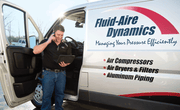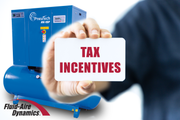First of all, what is a VSD (Variable Speed Drive) rotary screw compressor and how is it different than a fixed speed rotary screw compressor?
There is really only one key difference between fixed speed and variable speed drive rotary screw air compressors for sale: the way the motor is controlled. There is very little variation in the way the machine compresses air. Basically, a VSD machine varies the frequency and voltage supplied to the electric motor, thus allowing the speed of the motor to be efficiently controlled with the demand for air at any given point in time. On the other hand, a fixed speed compressor gives consistent frequency and voltage to the motor, meaning that when the demand for air is lower, the efficiency is lower because the frequency and voltage that is being given, is not being used to its fullest capabilities.
Variable Speed Drive Rotary Screw Air Compressors
VSD compressors hold large potential for significant energy savings if they are installed in the proper application and are correctly sized. Most machining and metalworking shops are considered the proper application and can justify VSD technology because it is common for them to have fluctuating demand. These businesses can be anything from single shift seasonal type businesses that have higher levels of production for three months out of the year, to a 24/7 shift operation that shifts 2 and 3 have different levels of air demand than shift 1. This change in energy consumption makes the fact that the initial cost is greater than a fixed speed worth it, because over time, the compressor makes and breaks its cost with lessened energy waste.
Even though VSD may be a good idea in many applications because of varying demands, there are many other factors to be considered to make sure that a VSD is a good fit. VSD compressors are very sensitive to incoming power inconsistencies. If there is any question as to power consistency, data logging should be done to confirm that there is no incoming power inconsistencies before a decision is made about a VSD compressor. They are also very sensitive to dirty, dusty, and wet ambient conditions. This being said, it can be challenging to put these machines on dirty shop floors or outdoors without good protection.
In a nutshell:
VSD benefits
- Reduced energy consumption (in the proper application)
- Quieter than a fixed speed when running at a lower RPM
- Consistent plant pressure
- Increased component lifetime
- Low inrush current during motor starts
- May qualify for energy incentives
Fixed Speed Benefits
- Lower capital cost
- Increased parts availability
- Lower maintenance and repair costs
- Most efficient in applications with a consistent demand
Read More: Why Choose or Upgrade to a Variable Speed Drive Air Compressor?
When would it make sense to have both a fixed speed and a VSD rotary screw compressor?
In many applications, especially larger applications (50+ HP), it can be ideal to run 1 or more fixed speed air compressor in conjunction with a variable speed drive. In this application you want your variable speed drive air compressor to have a larger capacity than the fixed speed. This concept is effective because as your demand increases, and the variable speed drive air compressor can no longer maintain pressure on its own, the pressure will reduce to a point that the fixed speed compressor will turn on. Because the fixed speed compressor has a lower capacity (because it is the lower HP unit) than the variable speed drive compressor, the fixed speed unit will run at 100 percent capacity allowing the VSD to reduce RPM and trim.
One of the advantages of this system design is that you are not relying on one large air compressor to run your whole machine shop. If you only have one air compressor and it is down for service, your whole plant could be down. If you have two smaller units, typically one unit can run at least 50% of your plant if the other is down. Another advantage is that this setup allows you to cover lower demands more efficiently. This advantage is explained more thoroughly in the example below.
Example:
Instead of installing one 100 HP variable speed drive that has a CFM range of 150 – 470 CFM, you could install one 60 HP VSD that has a range of 75 – 280 CFM, combined with a fixed speed 40 HP that has a CFM capacity of 190. This scenario gives you the same max CFM with the same HP, but has a greater overall CFM range.
Because the minimum range of a 100 HP VSD compressor is 150 CFM, at any point when the demand is below 150 CFM, the compressor will begin start and stop while running at its minimum capacity. It is less than ideal for the compressor to operate like this for extended periods of time due to a number of reasons.
In the scenario where you have the 60 HP VSD and the 40 HP fixed speed, when you are running above 280 CFM, which is the max capacity of the 60 HP unit, both compressors will be running together. When you are running under 280 CFM, the VSD will run by itself, and the fixed speed compressor will automatically turn off and enter standby mode. Being that the 60 HP VSD compressor is more efficient at lower CFM ranges than the 100 HP VSD, this scenario is more efficient overall.




